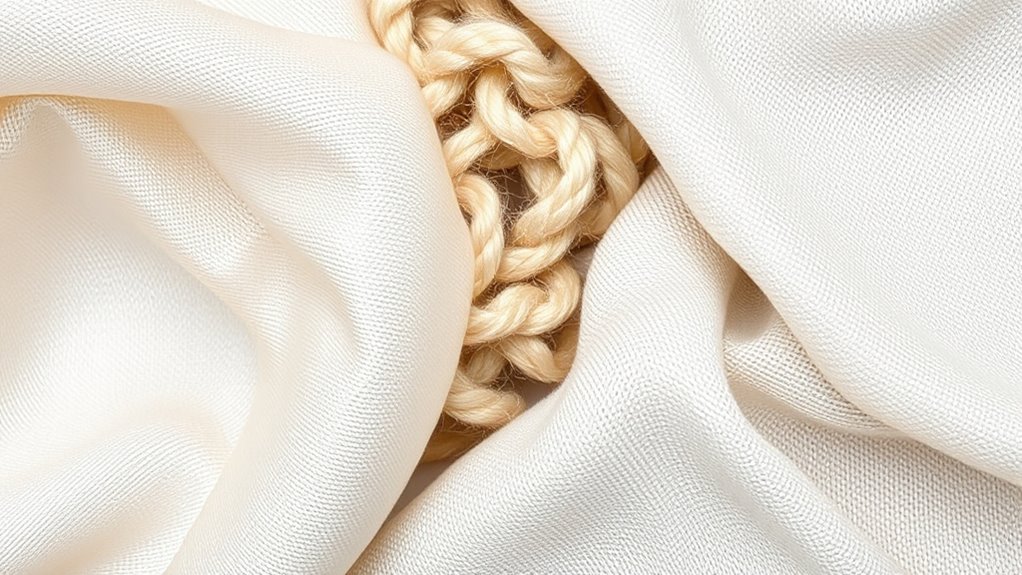Fabric science covers the properties of silk, wool, linen, and cotton, showing how each originates and reacts to dyeing and care. Silk is smooth and lustrous, responding well to immersion dyeing, while wool is resilient but needs gentle handling. Linen and cotton are strong and breathable, dyed with reactive dyes for durability. Knowing these differences helps you choose fabrics that last longer and stay vibrant, and if you keep exploring, you’ll discover how to care for each type effectively.
Key Takeaways
- Silk is a lustrous, smooth fiber from silkworm cocoons, valued for its elegance and dye absorption qualities.
- Wool, obtained from sheep, offers warmth, resilience, and responds well to skein dyeing for vibrant, complex colors.
- Linen is made from flax fibers, known for its breathability, strength, and suitability for dyeing with reactive dyes.
- Cotton, derived from cotton plants, is widely used, durable, and dyes effectively with reactive dyes for vibrant, long-lasting color.
- The choice of fabric depends on origin, dyeing techniques, and care requirements, impacting durability and appearance.

Have you ever wondered what makes different fabrics unique and how they’re made? When you look at silk, wool, linen, or cotton, each one tells a story of its origin, processing, and the techniques used to transform raw fibers into the textiles you wear. Understanding these basics can deepen your appreciation for fabrics and help you choose the right material for your needs. One key aspect that influences both the appearance and longevity of fabrics is dyeing techniques. These methods determine how vibrant colors appear and how well the dye bonds with the fibers, ultimately affecting fabric durability. For instance, silk, with its smooth and lustrous surface, responds beautifully to immersion dyeing, where the fabric is submerged in a dye bath, resulting in rich, even colors. Wool, on the other hand, often undergoes wool dyeing processes like skein dyeing, which allows for complex, multi-colored effects and enhances its colorfastness. Cotton and linen are typically dyed using reactive dyeing techniques that form strong chemical bonds with cellulose fibers, making the colors more resistant to washing and light exposure. The dyeing process not only influences the visual appeal but also impacts how durable the fabric remains over time. Proper dyeing techniques can considerably boost fabric durability by ensuring the color stays vibrant despite repeated washing and wear. Conversely, poor dyeing processes might lead to fading, uneven coloring, or damage to the fibers, compromising the fabric’s longevity.
Beyond dyeing, the inherent durability of each fabric type also plays an essential role in how long it lasts and how well it performs in different conditions. Silk, while luxurious and soft, requires gentle handling because its delicate fibers can weaken if exposed to harsh chemicals or excessive friction. Wool is warm and resilient but can be prone to pilling or shrinking if not properly cared for. Linen and cotton, known for their breathability and strength, tend to be more robust, making them suitable for everyday wear, but they can wrinkle easily and may require specific treatments to improve their resilience. The way each fabric is processed—such as whether it’s pre-shrunk or treated with durable finishes—further influences its durability. When shopping for textiles, considering both the dyeing techniques used and the fabric’s innate strength helps you pick materials that will serve you well over time. Proper care, along with understanding these factors, can extend the life of your garments, keeping them vibrant and intact for years. Ultimately, knowing how fabrics are made, dyed, and treated empowers you to make smarter choices, ensuring you select textiles that combine beauty with endurance.
Frequently Asked Questions
How Are Silk and Wool Sustainably Sourced?
You can guarantee silk and wool are sustainably sourced by choosing brands committed to eco-friendly fiber production and sustainable sourcing practices. For silk, look for certifications like OEKO-TEX or GOTS, which verify ethical and eco-conscious production. For wool, seek brands that prioritize responsible animal welfare, use organic or regenerative farming methods, and avoid harmful chemicals. By supporting these practices, you help promote environmental stewardship and ethical treatment within the textile industry.
What Are the Best Care Tips for Linen Fabrics?
Treat your linen like delicate artwork. Always wash it in cold water and use gentle laundry tips to avoid shrinking or wrinkling. For stain removal, act quickly—dab rather than rub to prevent setting. Hang your linen to dry or lay flat to maintain its shape. A friend once ruined a linen tablecloth by using hot water; now she always follows these tips, ensuring her linen stays fresh and beautiful.
How Do Fabric Blends Affect Durability?
Fabric blends can boost durability by combining materials with different strengths, enhancing overall fabric strength. The blend composition determines how well it withstands wear and tear; for example, adding polyester to cotton increases resilience and reduces wrinkling. You’ll find that blends with a higher percentage of synthetic fibers tend to be more durable, while natural fibers provide comfort and breathability. Always check the blend composition to understand its durability potential.
Are There Eco-Friendly Alternatives to Traditional Cotton?
Did you know that organic fibers like hemp and bamboo use up to 50% less water than traditional cotton? Yes, eco-friendly alternatives do exist. You can choose fabrics made from organic fibers that promote water conservation and reduce environmental impact. These options are not only sustainable but also durable and soft, making them a smart choice for eco-conscious shoppers who want to minimize their footprint while enjoying comfortable clothing.
How Does Fabric Weave Impact Breathability?
You’ll notice that fabric weave considerably impacts breathability. A looser weave creates more airflow channels, allowing better ventilation and keeping you cooler. Fabric density also plays a role; lower density fabrics have larger gaps, enhancing breathability. So, when choosing your clothes, consider fabrics with a loose weave and lower fabric density to stay comfortable, especially in hot weather. This combination helps maximize airflow and keeps you feeling fresh.
Conclusion
In fabric science, you’ve explored silk’s luxury, wool’s warmth, linen’s coolness, and cotton’s versatility. Each fiber has its unique charm and purpose, helping you choose the right fabric for every need. Remember, “a stitch in time saves nine,” so understanding fabrics now saves you trouble later. By knowing these materials, you can make smarter choices, ensuring comfort and style in every garment you wear.










